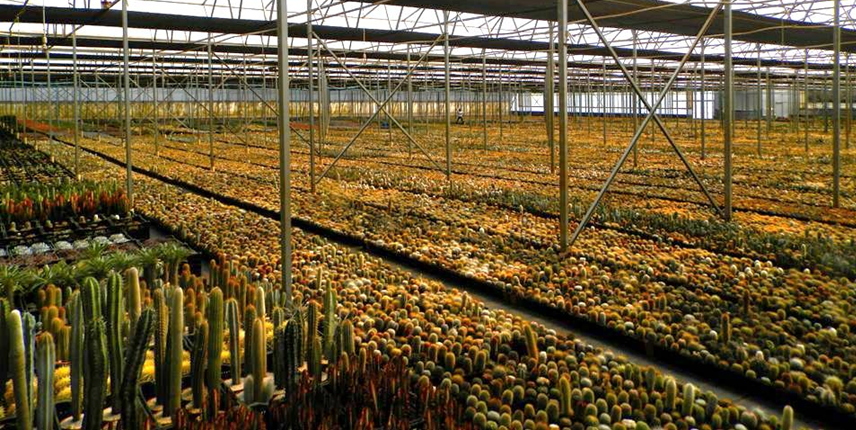A recent study provides a large number of genome size estimates for species within the cactus family (Cactaceae), offering great opportunities for studying the evolution of genome size in this family.
The study, which was published in Biological Invasions, has been carried out at the University of Coimbra (Portugal), with the collaboration of C·I·B Director David Richardson and former C·I·B post-doc Ana Novoa.
The total amount of DNA contained within one copy of a single complete genome is known as the genome size. Genome size varies more than 2400-fold among plant species (e.g., from 61 Mega base pairs (Mbp) in Genlisea tuberosa to 150 000 Mbp in Paris japonica), and it can affect traits related to plant growth, reproduction and dispersal. Naturalized and invasive plants often have disproportionately smaller genome sizes compared to other plants. Therefore, genome size has been used as an important predictor of plant invasiveness.
Hundreds of cactus species are being introduced to South Africa as seeds for ornamental purposes, and many of them are becoming serious invaders, imposing a wide range of negative impacts across the country. Therefore, predicting which cacti may become invasive in the future is crucial for preventing further invasions.
In their study, the authors explored the relationship between genome size and plant invasiveness within the family Cactaceae. They estimated the genome size of 256 cactus species that are being traded internationally, including 32 cactus species known to be invasive in South Africa. However, they found no significative differences in genome size between invasive and non-invasive cactus species.
“Our results suggest that genome size alone is not a reliable predictor of invasiveness in Cactaceae,” said Ana Novoa.

Read the paper
Lopes, S., Mota, L., Castro, M., Nobre, G., Novoa, A., Richardson, D. M., Loureiro, J., Castro, S. 2021. Genome size variation in Cactaceae and its relationship with invasiveness and seed traits. Biological Invasions, 1-16. https://doi.org/10.1007/s10530-021-02557-w
For more information, contact Ana Novoa at novoa.perez.ana@gmail.com
For more articles on cacti as invasive species
- A Novoa, G Brundu, MD Day, V Deltoro, F Essl, LC Foxcroft, G Fried, H Kaplan, S Kumschick, S Lloyd, E Marchante, H Marchante, ID Paterson, P Pyšek, DM Richardson, A Witt, HG Zimmermann, JRU Wilson (2019) Global Actions for Managing Cactus Invasions. Plants. doi: 10.3390/plants8100421
- A Novoa, V Flepu, JS Boatwright (2018) Is spinelessness a stable character in cactus pear cultivars? Implications for invasiveness. Journal of Arid Environments. doi: 10.1016/j.jaridenv.2018.09.013
- A Novoa, JJ Le Roux, DM Richardson, JRU Wilson (2017) Level of environmental threat posed by horticultural trade in Cactaceae. Conservation Biology. doi: 10.1111/cobi.12892
- H Kaplan, JRU Wilson, H Klein, L Henderson, H Zimmermann, P Manyama, P Ivey, DM Richardson, A Novoa (2017) A proposed national strategic framework for the management of Cactaceae in South Africa. Bothalia. doi: 10.4102/abc.v47i2.2149
- A Novoa, S Kumschick, DM Richardson, JRU Wilson (2016) Native range size and growth form in Cactaceae predicts invasiveness and impact. Neobiota. doi: 10.3897/neobiota.30.7253
- A Novoa, J Rodríguez, A López-Nogueira, DM Richardson, L González (2016) Seed characteristics in Cactaceae: Useful diagnostic features for screening species for invasiveness? South African Journal of Botany. doi: 10.1016/j.sajb.2016.01.003
- A Novoa, H Kaplan, JRU Wilson, DM Richardson (2016) Resolving a prickly situation: Involving stakeholders in invasive cactus management in South Africa. Environmental Management. doi: 10.1007/s00267-015-0645-3
- A Novoa, H Kaplan, S Kumschick, JRU Wilson, DM Richardson (2015) Soft touch or heavy hand? Legislative approaches for preventing invasions: Insights from Cacti in South Africa. Invasive Plant Science and Management. doi: 10.1614/IPSM-D-14-00073.1
- A Novoa, JJ Le Roux, MP Robertson, JRU Wilson and DM Richardson (2015) Introduced and invasive cactus species–a global review. AoB Plants. doi: 10.1093/aobpla/plu078



